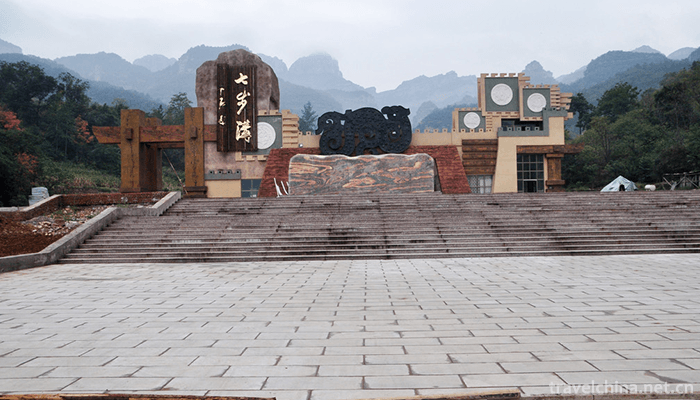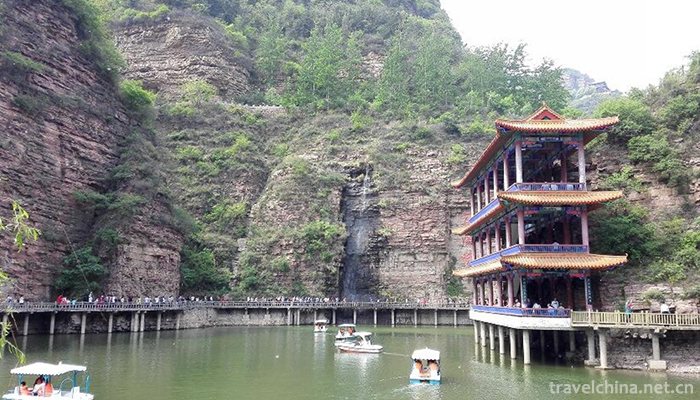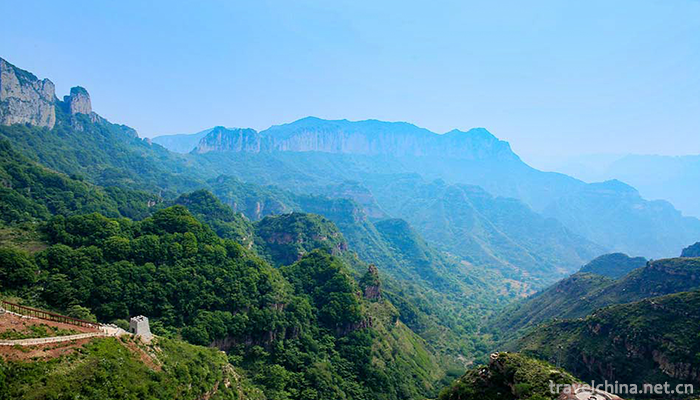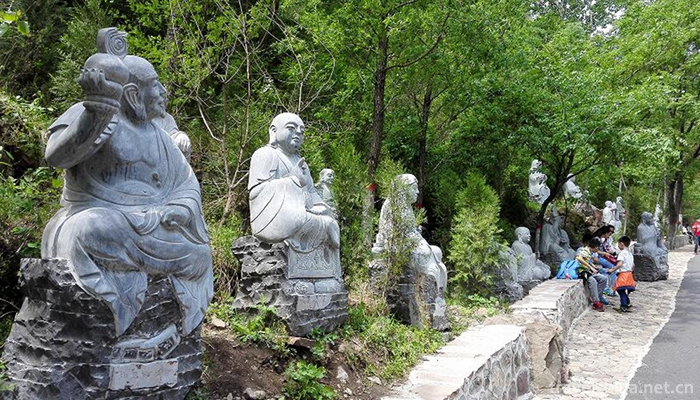Qibugou Scenic Area is located in Wu'an Huoshui Township, Handan City, Hebei Province. Wu'an National Geological Park and the hinterland of the National Forest Park, Hebei Province, with a total area of 15 square kilometers, consists of six scenic areas, namely, Gate Scenic area, leisure resort area, Baipu Gorge, Luohan Gorge, Sanling Mountain and Mawuzhai. It combines green, ancient and red tourism resources and unique geological resources.
Qibugou Scenic Area was redesigned in May 2009 with a total investment of 1.2 billion yuan. It has the first ski resort, high-altitude ropeway, CS live shooting, outward bound training, tourist center and four-star Tianmen Lake Hotel in southern Hebei Province. It is a national AAAA-level tourist attraction and a key tourism construction project in Hebei Province.
geographical environment
Qibugou Scenic Area is located in Wu'an Living Water Township, Handan City, Hebei Province, the hinterland of Wu'an National Geological Park and National Forest Park, with a total area of 15 square kilometers.
natural resources
Qibugou, formerly known as "Lacquer Tree", is named for the lacquer trees growing in the mountains and the common people's livelihood of lacquer shop. Since the Tang Dynasty, Buddhist monks have gathered here to live in seclusion, taking the Buddhist allusion "seven steps lotus flower", which was renamed "seven steps ditch" in the Qing Dynasty. In the reign of Kangxi in the Qing Dynasty, Ren Siyin wrote a highly praised Monument to the Luohan Cave: "Where is this? It's neither heaven nor earth nor human. "Mountains are rolling with clouds and clouds, and all the saints are hiding in dragons and tigers. Buddha's heaven is so close that he can't wander around and forget himself in Dengsi's realm! uuuuuuuuuu
Traffic information
Public Transportation: Take Bus 808 from Handan to Wu'an Bus Station, transfer to Bus from Wu'an to Cheyang-Changshou Village, and get off at Qibugou on the way.
Self-driving: Handan City West-Handan-Wu Expressway-Wuan City West Ring-Shahuang-Jingniang Lake-Qibugou
Shijiazhuang Direction: Beijing-Hong Kong-Macao Expressway-Qinglan Expressway-Xikou of Handan-Wuan City-Qibugou
Jinan Direction: Qinglan Expressway, Xikou of Handan - Wuan City - Qibugou
Zhengzhou Direction: Beijing-Hong Kong-Macao Expressway-Qinglan Expressway-Xikou of Handan-Wuan City-Qibugou
Changzhi Direction: Qinglan Expressway Shexian Longhukou-Guzhen-Yangyi-Shahuang-Qibugou
Scenic spot construction
Qibugou scenic spot was developed in 2003.
The first phase (May 2009 - May 2012) focuses on the construction of Gate Scenic area, Baipuxia scenic area, Luohan Gorge scenic area, ski resort, Tianmen Lake Hotel, tourist reception center, ropeway and other supporting services.
It went into operation on May 1, 2012. Phase II (May 2012 - 2020) projects include Mawuzhai, the site of the 129th Division Hospital of the Eighth Route Army, Luohandong Temple complex, five-star standard resort area, Sanlingshan outdoor development training, SC real gun shooting, water park and other supporting projects, as well as scenic areas not fully developed.
Main attractions
Tianmen Mountain
The peak body is red quartz sandstone of Mesoproterozoic, with cliffs on all sides and elevations above 1000 meters. Its top is gentle. It is called Fangshan in geology. They are like two mountain gods guarding the gates of Qibugou. Through these gates, thousands of Meteorologies of Qibugou scenic spot are still in sight.
Mountain Gate
The grand momentum, simple and unique, is a imitation of the Han Dynasty architecture. Shanmen embodies the Han culture of the scenic spot. The front "Qibugou" is inscribed by Ouyang Zhongshi, a calligrapher, and the back is inscribed with the record of Ma Wu in Houhan Shu. The bronze sculpture hanging in the middle is the shape of the Dragon when it was born, and the four white jade reliefs beside it are the four gods of Taoism: Qinglong, Baihu, Suzaku and basalt.
Ski Field
Located in the southeast of Qibugou Scenic Area, the ski resort covers an area of 150,000 square meters and is the first ski resort in southern Hebei Province. The ski resort lasts for more than 120 days. The huge artificial snow-making system covers every ski track, which makes Qibugou Ski Resort have the advantages of good snow quality, large amount of snow and long snow period. The ski resort has one international standard intermediate ski track, one primary ski track, one flying saucer ski track and children's recreational area. It has advanced international snow-making and snowboarding equipment and internationally renowned brand ski equipment.
Nan Tianzhu
South Tianzhu is a peak pillar formed by joints, collapses and weathering of quartz sandstone. It is over 100 meters high, rising from the ground and rising into the clouds. The low-lying terrain around it highlights the characteristics of its isolated peaks in the distance, so it is called "South Tianzhu". Near, looking up, the walls are steep, like knives and axes. The shape of the peak is peculiar and its ornamental forms vary from different angles. The local people also call the peak "the root of life", which is also called "Yangshan" in the tourism industry.
Tianmen Lake
Located at the foot of Tianmen Mountain, the water area is more than 1000 square meters. The majestic Tianmen Mountain is reflected in the lake. The lake is beautiful and magnificent. In the southeast corner of the lake, there is a water reading pavilion, which means a lot. From here to the north, the flood season can flow over the dam. From this to the west, the winding bridge along the lakeside is called the winding bridge, which implies the winding and bright road of life.
Bai Pu Gorge
This gorge is about two kilometers long. In rainy season, there are many waterfalls and springs, so it is called Bai Waterfall Gorge. This gorge is the main body of Qibugou Waterscape, with its thousands of shapes, twists and turns, time-quiet and time-smooth, and continuous flow of water throughout the four seasons. The lower part of the gorge forms many beautiful mountains and lakes according to the situation of the gorge, either natural or artificially, which are connected with the upper part of the gorge. Every summer and autumn, mountains and rivers roar and rush down, and the gorges and waterfalls make the deep and winding Gorges misty and extremely cool.
Tian Jinghu
Located in the middle of Baipu Gorge, the water of Baipu Gorge falls down along the cliff and forms a beautiful waterfall. Beneath the waterfall is a huge pool of water more than twenty meters deep. Surprisingly, this clear deep green pool is surrounded by three sides of the ring-shaped mountains, leaving only the eastern side to form a natural dam.
Luo Han Xia
The mountain gorge north of Tianjing Lake is called Luohan Gorge, which leads to Luohan Cave and Baiyun Temple in the "Secret Ancient Buddhist Land". The scenic spot is decorated with 500 statues of Luohan.
129 Division War Readiness Hospital
The 129th Division War Readiness Hospital, hidden between the steep mountains. During the War of Resistance Against Japan, Liu Bocheng, who was in the mountainous area of Taihang, visited the wounded soldiers in the hospital by Deng Xiaoping. Now as a patriotic education base for visitors.
Ma Hu Zhai
The Ma Hu village at 1680 meters above sea level is a training ground for Liu Xiu to build a general of the Eastern Han Dynasty. Climbing high and looking far, stretching too far to catch a panoramic view.
Tourism information
Ticket information
Adult tickets: 80 yuan per seat.
Children under 1 meter height are exempted from tickets; elderly people over 70 years old hold valid certificates; officers and soldiers hold valid certificates; disabled persons hold disability certificates.
Children between 1-1.5 meters in height are entitled to half-ticket; elderly people between 60 and 69 years old are entitled to half-ticket with valid certificates; full-time students are entitled to half-ticket with student certificates.
Opening Hours
Year-round: 08:00-18:30




0 Questions
Ask a Question
Your email address will not be published.